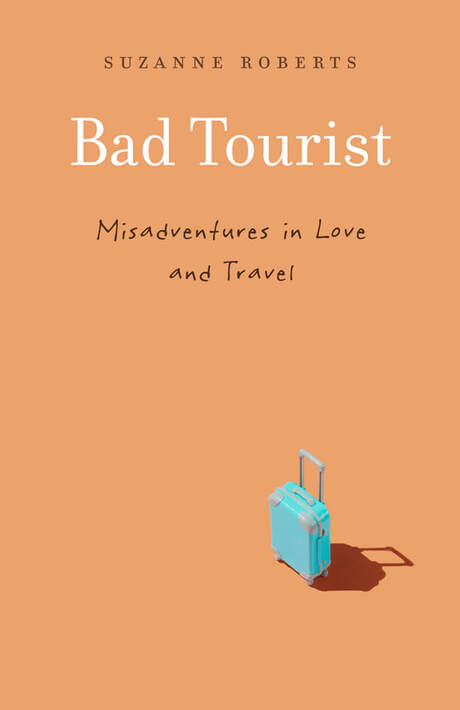Travel Writer Suzanne Roberts is a ‘Bad Tourist’
By Pam Anderson
Posted on

As a student in the Sierra Nevada University MFA program, I recently got to sit down with Suzanne Roberts to discuss her latest book, the memoir Bad Tourist (University of Nebraska Press, 2020). Beyond being a writing instructor, Roberts is an accomplished travel writer, named “The Next Great Travel Writer” by National Geographic Traveler Magazine. Her previous book Almost Somewhere: Twenty-Eight Days on the John Muir Trail (Bison Books, 2012) won the 2012 National Outdoor Book Award. Roberts has also published four volumes of poetry.
Even though I have had classes with Roberts and have attended literary events where she was in attendance, until I read Bad Tourist, I can’t really say that I knew her. To be honest, she intimidated me: she is a demanding instructor, and while friendly, she is unabashedly forthright. Plus, she has lived a life of big travel and big adventure, and my experiences felt small next to hers. But as I read Bad Tourist, I came to understand her better as a woman not much different than most women I know: she is insightful, brave, and honest, but also has been afflicted with some of the insecurities that many of us have, questioning her choices and wondering if she is “enough,” even as she tries to experience everything she can in life.
According to the book’s overview, “Bad Tourist takes us across four continents to fifteen countries, showing us what not to do when traveling. A woman learning to claim her own desires and adventures, Suzanne Roberts encounters lightning and landslides, sharks and piranha-infested waters, a nightclub drugging, burning bodies, and brief affairs as she searches for the love of her life and finally herself.” Readers who know Roberts as a travel writer may pick up Bad Tourist expecting a travel book, and while the backdrop is travel, this is very much a memoir of personal growth.
Bad Tourist is organized thematically. In our conversation, Roberts shared that she used this format because she didn’t want her narrative to unfold chronologically. Roberts wished she hadn’t used chronological organization for her first book Almost Somewhere; in fact, she said the book feels “plodding” to her now. I wondered if Roberts had received feedback on the thematic organization of Bad Tourist, and she said that several early reviews have questioned this choice. As a reader and reviewer, though, I can say that I enjoyed the structure. I had to pay attention to the location and timing and people involved to put each essay into perspective. I appreciated the non-linear trajectory, as personal growth is rarely linear.
Roberts told me that Bad Tourist began as a traditional memoir, something like an edgier Eat, Pray, Love—she thought maybe something like Drink, Fly, Fuck. Her original idea for that book eventually became something else: a memoir about her mother (which she will be working on in the future). So, she looked at the essays of her travels she had collected, and when she began organizing them into what she calls an “anti-guidebook,” she had the story of a narrator “in search of a more authentic version of herself.”
The title refers less to being a bad tourist and more to decisions that make Roberts feel like a bad tourist in her own life. Throughout the stories, there are fewer “tourist faux-pas” than personal mistakes. Roberts bares lots of questionable choices (cheating on her husband, sleeping around, trusting people too quickly, to name a few), but she is honest and unflinching in her admissions. Roberts told me that much of the sting of her mistakes is already gone, as she has worked through the ones she wrote about. Roberts also said that feeling guilty about mistakes is less productive than actually working on change. As a reader of Bad Tourist, it’s clear that with each new adventure, she works on “being better.”
My favorite essay is the one entitled “Skiing the Fall Line.” In this episode, Roberts and her first husband are backcountry skiing, and they meet up with another skier, Susan, who joins their group. Roberts studies and admires Susan, and later reflects that Susan was the kind of woman Roberts “wanted to be—independent and sure of herself.” And then later in the essay, she writes, “Backcountry skiing and hiking adventures had become a way for me to seem brave without really being brave—a way of playing tourist in my own life.”
For me, as someone who also loves to travel, those words really hit home; I understood how we allow ourselves to try on identities in other places, simply because we can. The moment Roberts recognized she was playing a tourist in her own life is when I really connected with her. Then, at the end of the essay, she writes, “I would travel to escape and then to find myself; I would travel, finally, to come home.” These lines are key to the entire memoir, as throughout all her travels, what Roberts is really searching for is a way to come home.
As we wound down our conversation about Bad Tourist, I asked if, as a memoirist who shares many aspects of her personal life, Roberts had acquired a “thick skin.” I found her answer intriguing because she is at once both sensitive about how people may view her and her book, but then also dismissive, adding, “But who cares?” Roberts, like many women—myself included—continues to work on balancing owning her mistakes and regrets with moving through the world with a fierce confidence that hasn’t always come naturally. Bad Tourist is highly relatable, even for a reader who has not traveled around the world. Skillfully, Roberts reminds us that our adventures, regardless of where they occur, force us to stumble and grow until eventually, we find our way back to our authentic selves, and back to our true homes.
– Pam Anderson